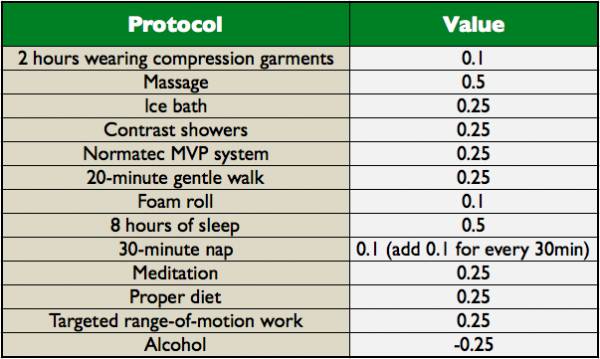A while ago I wrote about training and recovery, putting it into an equation. The equation was simple:
Training Effect = Work x Recovery
In simple terms, if we take T (training) to be one unit for a typical session, then to make the TE (training effect) actually show the benefits of the training, the R (recovery) needs to be at least equal to one.
But most people aren’t adequately recovering. In addition, if you suffer from range-of-motion deficiencies, you should be focusing on those, first and foremost, as they have a massive impact on the rest of the equation. In fact, if you make the rookie mistake of just worrying about the training aspect, then you will never progress.
To make the jump to full recovery, you’ll need some kind of targeted recovery.
A Simple Tracking Tool
Here’s a simple chart to track recovery. The goal is to add your points up to one for each day during normal training:

In a given day, even getting eight and a half hours of sleep (likely broken into eight hours of sleep plus a nap) coupled with eating well still only gives you a score of 0.85. To make the jump to full recovery (a value of at least 1.0), you’ll need some kind of targeted recovery work such as a contrast shower or recovery flexibility work.
Don’t Underestimate the Small Things
If you start tracking your recovery like this, you’ll quickly see areas where improvement can be made. The more I have delved into this, the more interesting the discoveries have become.
Massage, for instance, even done once per week, is much more powerful than foam rolling and other self-release work. So much so that a single weekly session of massage is at least equal to daily self-myofascial release work.
“We all go to the gym and train expecting to see improvement. But with five hours sleep per night, poor diet, and no other recovery strategies in place, you won’t see much, if any improvement.”
In addition, meditation and other internal martial arts practice, such as qi gong, have actually been found to nearly double the results of all the other factors on the table except for sleep.
Read that last bit again. Deliberate time spent on things like meditation, tai chi, and qi gong improves all the other recovery factors. Dr. Chris Holder, strength and conditioning coach at Cal Poly, conducted a study on his athletes and found that because the quality of their sleep improved so dramatically thanks to the benefits of these practices, that the other recovery methods went from slightly helpful to incredibly beneficial. Sleep is the biggest recovery weapon you have in your arsenal, and some of the more esoteric, yet ancient practices are showing great value in boosting the effectiveness of sleep.

A single weekly session of massage is at least equal to daily self-myofascial release work.
All Sessions Are Not Equal
But this still isn’t the full picture of the training effect equation. This depicts only how to adapt to the training load and assumes that all sessions are equal. It also assumes that each session only takes you to the limit of your current ability. A workout that equals 70% of your current ability only needs an R value of 0.7 to recover from.
This is why cycling intensity and volume throughout the week become so important. The reality of most people’s lives is that they will never attain a full R score of 1.0 on a given day. It’s just unrealistic.
“[M]editation and other internal martial arts practice, such as qi gong, have actually been found to nearly double the results of all the other factors on the table except for sleep.”
But what happens if a person can get an average score of 0.85 daily over the course of the month? This is the person who does get eight hours sleep each night, eats clean, and manages to remind him- or herself to foam roll daily. (This is an atypical person, by the way, and should be applauded for this effort.)
If you make the average level of effort, T, slightly less than equal to 0.85 over the month period, then you will fully recover. A score of 0.85 would have you rested, but not rested enough to see fitness improvements. You could do that by modulating the effort level of each workout as follows:
- Workout 1: 1.0 (or 100%)
- Workout 2: 0.6
- Workout 3: 0.8
- Workout 4: 0.7
- Workout 5: 0.85
Following this sort of pattern gives an average intensity of 0.8 – just enough recovery ability left to see a marginal improvement over the month. And this is the hard thing for many people to get their head around – you don’t need more training, you need more recovery. If, for whatever reason, your recovery begins to drop because of work, school, family stress, or illness, then your training effect will be changed negatively.
It’s an easy trap for many of us to get stuck in. We all go to the gym and train expecting to see improvement. But with five hours sleep per night, poor diet, and no other recovery strategies in place, you won’t see much, if any improvement. So most people try coming more often or working harder. But the real trick to improving is not to add more work but to beef up other half of the equation and add more recovery.

Deliberate time spent on things like meditation, tai chi, and qi gong improves all the other recovery factors.
The Reality of Training
Not every session is created equal either when it comes to what it costs you. A two-hour run will take longer to recover from than a thirty-minute run. I know from personal experience that when I first started doing longer runs, it took a couple of months to see the benefits. Likewise some sessions in the gym may leave you sore for days.
“The reality is that training effect is not built from a single workout, but rather a combination of the weeks prior.”
But that doesn’t mean you shouldn’t do these sessions, as they absolutely serve a purpose. A workout that has a W score of 1.1 or 1.2 is incredibly helpful to take you to the next level. But actually reaching that next level mandates that you follow those hard sessions with ample recovery.
The reality is that training effect is not built from a single workout, but rather a combination of the weeks prior. The benefit of that reality is that you can essentially stockpile some of your R points to help you recover from these occasional very hard bursts. By having more light and medium days (scores of 0.6-0.8) you can save up some of your recovery and end up with a slight surplus to help you overcome the harder workouts (0.85+).
Recovery Rules
Some rules for making sure you recover suitably and structure workouts for optimum benefit:
- Always follow your hardest session with your easiest.
- If you add work to your week in order to speed up the process, don’t add in more hard work. Instead add in easier sessions of 0.6-0.7, as these leave plenty of recovery ability and leave surplus to help you recover from the harder sessions that may have a T score of 1.0 or more.
- It is your average workload and recovery over time that matter, not a single session or night’s sleep.
- For best results, keep your average workload somewhere between 0.7-0.8. This should put you in a recovery surplus over time and allow for adaptation. Don’t try to out train your recovery ability.
Further Reading:
- How Your Recovery Relates Directly to Your Performance
- How Much Recovery Do You Need? 7 Factors to Add Up
- Repeat After Me: There Is No Such Thing as Overtraining
- New on Pulse Beat Fit Today
Photos 1 courtesy of CrossFit Impulse.
Photos 2 and 3 courtesy of Shutterstock.






